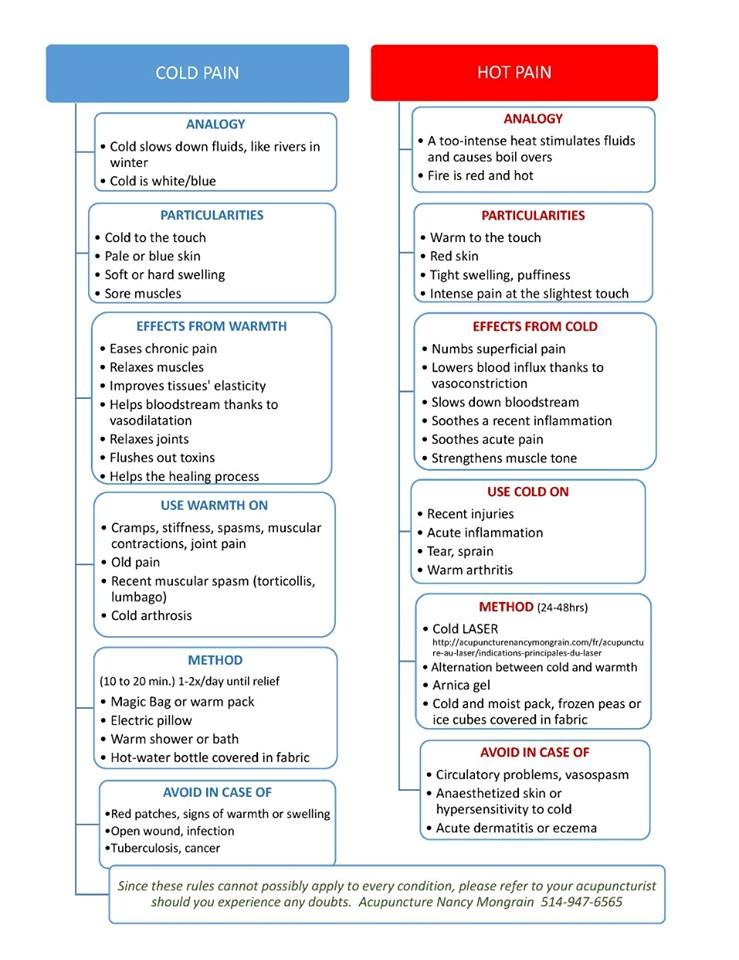
Home » Articles and news » Should I apply cold or warm packs?
Article « Hot or Cold »
Should I apply cold or warm packs? (part 1)
TCM often proves itself useful in places where we have already tried everything else. Its strength, more especially in terms of acupuncture, is differentiating “COLD PAIN” and “HOT PAIN”. With that in mind, the logic is very simple: all you have to do is apply the opposite temperature in order to restore balance. Choosing whether to use warm or cold packs will depend on the type of pain (either “hot” or “cold”), on how long you have been experiencing this pain and on the inflammation level.
TCM associates blockage with pain, so it is important to activate the circulation of healing and nourishing fluids within the joints, muscles and organs.
Since our body is 70% water, it reacts to temperature variations, exactly like how water will freeze in the freezer and then melt and return to a liquid state on the range. Consequently, it is imperative to correctly identify the very nature of the pain before using thermotherapy. To this end, compare your pain to the healthy contralateral limb or joint. Is it :
a. Warmer or colder?
b. Darker or paler?
c. More swollen? (a sign of an undifferentiated inflammatory condition)
Using the following chart, you will then be able to choose the correct thermotherapy. In doubt, your acupuncturist can help you.
See the second part of this article as well as the table in this same “articles’ section.
Nancy Mongrain | Licenced Acupuncturist
Membre de l’Ordre des Acupuncteurs du Québec
Sources :
Giovanni Maciocia, La Pratique de la Médecine Chinoise.
The treatment of pain_Sun Peilin
http://www.acupuncture-belgique.be/2014/12/brisons-la-glace/
http://garyreinl.com/iced.html
http://www.psy-med.ca/portfolio_page/douleur-musculaire-faut-il-traiter-avec-du-chaud-ou-du-froid/
https://www.youtube.com/watch?v=tJwqxZcG9m4
https://oppq.qc.ca/articles_blogue/entorse-cheville-methode-rice/
Should I apply cold or warm packs? (part 2)
If you have read the introduction and the quick-reference chart about “cold pain” and “warm pain”, you might be curious to learn more about it, this time from the Western medicine perspective.
Since understanding is remembering, this second part will help you choose the appropriate therapy for your pain, especially for those times when you do not have access to the quick-reference chart.
COLD PAIN (WITH OR WITHOUT INFLAMMATORY FACTORS)
Do you experience the same stiff pain when you wake up or after a long idle period? Were you exposed to continuous cold or wind? Is the sore area colder or paler than the healthy one? Cold, glacial winds and inactivity can cause muscle contracture, just like a river freezing in winter. That muscle will then crush its own vessels, which will stop the regular blood flow. Thus deprived of blood, the muscle will get colder, and the lack of glucose, oxygen and other nutrients will trigger a metabolic crisis (it is hungry!) This will cause neuromuscular dysfunctions and create muscular knots, also known as trigger points (http://www.triggerpoints.net/). The weak blood flow will worsen the cold pain, thus establishing a vicious circle.
If you would rather enter a virtuous circle, use warmth to relieve the pain (hot and wet towel, electric pillow, Magic Bag, hot-water bottle, etc.). This will relax the muscles pulling on your tendons and joints and reactivate the flow of restorative fluids. If you are still in pain after several days, hot needles and Moxa http://www.acupuncturetoday.com/abc/moxibustion.php will greatly help deactivate the dysfunctional motor nerves creating the muscular knots.
In some rare cases, reactivating the blood flow after a chronic blockage can temporarily increase the pain. Your condition should, however, quickly improve. If not, it means there is an underlying warm inflammation, and you should not apply warmth on it. Contrary to popular belief, hot/cold ointments do not replace warm packs.
They become however useful by confusing the brain: thus incapable of knowing if the skin is warm or cold, it will trigger its pain-relief mechanisms.
WARM PAIN (AUTOMATICALLY INFLAMMATORY)
TCM (Traditional Chinese Medicine), just like physiotherapy, chiropractic and osteopathy, allows a very moderate use of cold packs to treat acute inflammations (red, warm, puffy) caused by traumas, contusions or heavy therapeutic manipulations. However, you should only use cold packs for 24 to 48 hours. Even though cold momentarily anaesthetize the pain, it also slows down the healing process, since it deprives the affected area from nutrients, and can create muscular contractions. I strongly recommend cold LASER therapy instead. It could greatly accelerate the healing process if used during the first 48 hours (please call or text me immediately).
If the inflamed area is still abnormally warm and red, please contact your doctor.
COLD PAIN PREVALENCE (for Nordic countries)
My extensive experience working with injured workers and victims of car accidents in multidisciplinary clinics and private practice (where 40% of patients confirmed the prevalence of cold pain) tells me that warm pain is much rarer than we think. This is why I suggest using warm packs at least 90% of the time, since their short and long-term effect is more often than none the most beneficial. I have treated countless patients suffering from chronic pain caused by an overuse of cold packs. Their condition greatly improved once they switched to warm packs. When in doubt, your acupuncturist can help you clarify the situation.
To conclude, here is priceless tip: never let pain become chronic. After three months, the pain signal insidiously settles in the limbic system, causing the unpleasant feeling to remain even though the injury has healed.
If you have any question, do not hesitate to contact me.
Nancy Mongrain | Acupuncteure
Membre de l’Ordre des Acupuncteurs du Québec
514-947-6565
Acupuncture Montréal Centre-Ville

